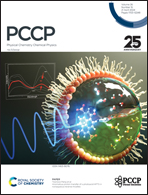Three-body interaction of gold nanoparticles: the role of solvent density and ligand shell orientation†
Abstract
Molecular dynamics simulations are used to study the effective interactions of alkanethiol passivated gold nanoparticles in supercritical ethane at two- and three-particle levels with different solvent densities. Effective interaction is calculated as the potential of mean force (PMF) between two nanoparticles, and the three-body effect is estimated as the difference in PMFs calculated at the two- and three-particle levels. The variation in the three-body effect is examined as a function of solvent density. It is found that effective interaction, which is completely repulsive at very high solvent concentrations, progressively turns attractive as solvent density declines. On the other hand, the three-body effect turns out to be repulsive and increases exponentially with decreasing solvent density. Further, the structure of the ligand shell is analyzed as a function of nanoparticle separation, and its relationship with the three-body effect is investigated. It is observed that the three-body effect arises when the ligand shell begins to deform due to van der Waals repulsion between ligand shells. The study provides a deep insight into good understanding of the solvent evaporation-assisted nanoparticle self-assembly and can aid in experiments.



 Please wait while we load your content...
Please wait while we load your content...